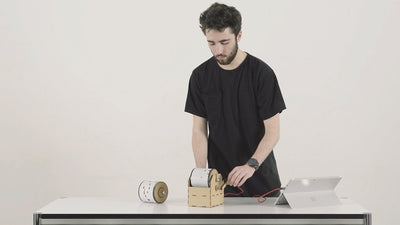Plinkt - A Conductive Paint Drawing Machine

Product designer & industrial design engineer, Jose Riesco used our conductive paint in his mechanical drawing machine, allowing the user to design and create many sensors.
In an increasingly connected society, technology is indisputably part of everyday life. However, the design and creation of electrical and interactive circuits in the field of design, and other creative areas is currently an undeveloped skill, and unknown in many cases by the user and final consumer.
This project tries to respond from an approach based on industrial design, the latent problem of the understanding and use of electronics, through the use of conductive inks. Having carried out an investigation on the existing solutions in the current market, and on the different kinds of conductive inks, the project's value proposition tries to solve the problem by approaching it from a different perspective.
The final result is Plinkt, an interactive circuit drawing machine, which uses Electric Paint and with which the user can design, prototype and create many projects and ideas in an easy and simple way.
The challenge of this project is to design a system with which to facilitate the incursion into the world of electronics to those users who are not equipped with sufficient knowledge of this area. It seeks to achieve this challenge in a creative way and with its own expression; an approach only possible from an industrial and product design point of view.
The origin of this challenge arises both from Jose's professional and academic experience, as well as from his personal experience, exploration and experimentation with conductive inks.
Throughout these last years, Jose has observed how in many of the projects or tasks in which he has been involved, there were stages in the development process that the use or prototyping of electronic elements was necessary. Also, he has observed how this need, produced a certain concern or detachment for those members of the teams which, either they didn't have the knowledge of the fundamentals of electricity and electronics, or because they were lacking the learning opportunity.
In a world in which every day we observe the implementation of technological entities in products of all kinds, Jose thinks that there is no better time than today to develop this type of project.
To be able to run tests with the inks in order to make feasibility and operation checks, a prototype injector was developed with a stepper motor, a 5cc syringe and self-produced 3D printed parts. The prototype was first incorporated into the extruder of a 3D printer, and as a second option, it was coupled to the structure of a drawing plotter.
In both cases, it was confirmed that the idea of printing circuits with conductive ink was feasible. Within the experimentation phase, Jose also checked if those "printed" circuits using the designed prototype were functional, obtaining a positive result as can be seen in the pictures.
The drawing machine is capable of creating interactive circuits (electrical circuits, sensors) through the use of conductive ink. To be able to do this, the user will have an ink refill, which will be injected into the paper by the machine itself following the shape designed by the user.
After observing the inks' behaviour, it proved that they work best when they are applied in traces of small length since the resistivity decreases considerably.
This mechanical drawing machine is a portable object, which has a range of movement of 80x80 mm, allowing for a considerable drawing area for a device of this size and these characteristics.
All along with this project, Jose used Electric Paint and the Touch Board and other electronics such as Arduino, CAD Modelling, 3D Printing, Laser Cutting, CNC Machine Milling, etc.
One of the biggest challenges he faced in this project was a series of essential calculations for its operation, such as the speed and amount of ink flow supplied by the injector when the machine is running. As well as the duration in quantity of the interchangeable ink cartridge.
After performing the necessary calculations, he obtained both empirical and experimental results, that with the full capacity of a cartridge, which is just 2.83 cc of ink, a length of 1132 meters can be drawn, with a stroke thickness of 0.41 mm. That makes the use of ink much larger compared to a manual method application.
The result is Plinkt Drawing, an interactive circuit drawing machine which aims to democratise the use of electronics in the creative environment. With Plinkt the user can design, prototype and create countless projects and ideas through the use of conductive inks, printing it on a wide range of different kind of materials such as papers, plastics or textiles.
The users just have to draw any design in vectorial format and then connect the device to the computer. The Plinkt app converts this drawing into G-Code. Once the button START is pressed, the instructions are sent directly to the machine.







